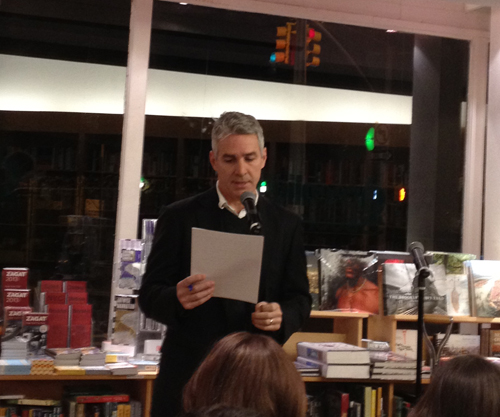
John Kenney, a former advertising professional, debuted his new novel, Truth in Advertising at Greenlight Bookstore. He was joined by novelist Jami Attenberg, author of The Middlesteins. Kenney begins by joking that Attenberg, a seasoned novelist who has long participated in readings, suggested to him that it was customary to read from the novel of the host — a joke that sets the evening’s tone.
Kenney opens a folder, the reading printed out on white paper. He reads softly, almost rambling, but the tongue twisting language of his text spills from his mouth with ease. The diction provides whimsical phonetics. The sounds are fun. The names of the corporations are fun.
Kenney eases into the cadence of the narrative, and quickly he finds the comic timing he needs for delivering dialogue and one liners eliciting more laughter from the audience. The novel seems premised on humor, a theme reiterated throughout the event by Attenberg and Kenney. This book, they promise, will make you laugh. Perhaps they merely present a good ad pitch, but the selection Kenney reads is funny.
He finishes reading and Jami Attenberg joins him in front of the microphone. Attenberg begins by saying they both worked at the same ad agency once, but neither knew each other at the time because she worked in digital media. No one thought digital was going to amount to anything then, Kenney joked. Both he and Attenberg are self deprecating in their comedy, and natural performers. She continues by saying neither of them were smart enough for an MFA in creative writing.
The novel focuses on an advertising executive responsible for a last minute ad campaign, an industry novel about an industry popularized in recent years by Mad Men. The easy route would be to attack a profession paid to lie, but Kenney explains he didn’t want to “shit” on advertising. He’s a veteran of the business afterall, and its “indoor work with very little heavy lifting.” Working in advertising taught him to write fast, though little else but a salary.
Attenberg and Kenney go on to discuss the humorous elements of the novel. They are both making a hard sell on how funny the book is. Attenberg explains that there are elements to The Middlesteins that were funny, but it was more sad than Kenney’s book; Kenney worried about having emotional gravitas displaced by the humor. His first attempted novel was “dark, relentless” and everyone who read it asked him why it wasn’t funny. They expected that from him. His second attempt failed in that way too. For Truth in Advertising, Humor provided the missing structure.
Kenney goes on to explain that commonly, first time novelists end up drawing on autobiographical experiences. He understands why, but beyond the location and occupation, he really hadn’t included much by way of personal experience. He wrote the novel with a first person narrative voice even even though everyone told him a third person perspective was often easier for first time novelists. He said the first person perspective simply felt safer. He cites Don DeLillo’s Americana and Joshua Ferris’s And Then We Came to The End as two novels he read with a critical eye in anticipation of writing.
With the novel’s release, his book is now open to the scrutiny of reviewers. Attenberg mentions that Amazon and Good Reads reviewers are the worst and she never reads them. Novelists spend years writing a book and the internet reviewers will write a single disparaging word in ten seconds. (The internet really is the worst.) Despite the frequent rejections from clients, the advertising world failed to prepare Kenney for the types of criticism he has while writing a book — a deeply personal product in comparison to an ad pitch.
Lastly, Attenberg wrapped things up by asking Kenney what writing, fiction in particular, meant to him. Kenney responded: “fiction helps me understand what it means to be human.”
John Kenney and Jami Attenberg
Wednesday, January 23, 2013
Greenlight Bookstore